最新反义疑问句知识点
- 格式:doc
- 大小:66.50 KB
- 文档页数:11
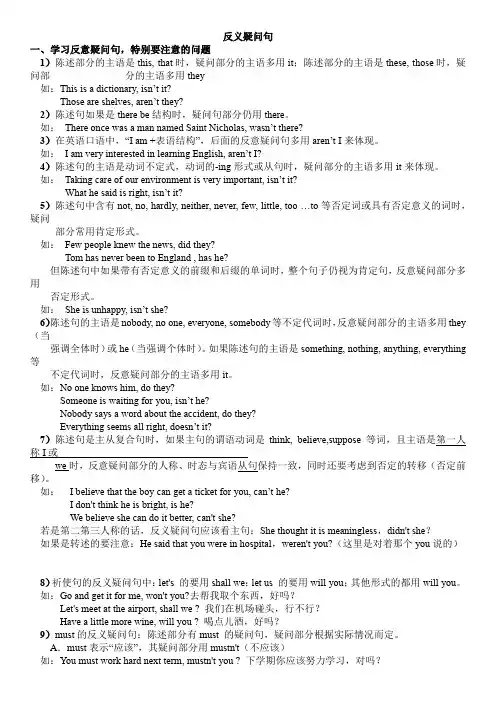
反义疑问句一、学习反意疑问句,特别要注意的问题1)陈述部分的主语是this, that时,疑问部分的主语多用it;陈述部分的主语是these, those时,疑问部分的主语多用they如:This is a dictionary, isn’t it?Those are shelves, aren’t they?2)陈述句如果是there be结构时,疑问句部分仍用there。
如:There once was a man named Saint Nicholas, wasn’t there?3)在英语口语中,“I am +表语结构”,后面的反意疑问句多用aren’t I来体现。
如:I am very interested in learning English, aren’t I?4)陈述句的主语是动词不定式,动词的-ing形式或从句时,疑问部分的主语多用it来体现。
如:Taking care of our environment is very important, isn’t it?What he said is right, isn’t it?5)陈述句中含有not, no, hardly, neither, never, few, little, too …to等否定词或具有否定意义的词时,疑问部分常用肯定形式。
如:Few people knew the news, did they?Tom has never been to England , has he?但陈述句中如果带有否定意义的前缀和后缀的单词时,整个句子仍视为肯定句,反意疑问部分多用否定形式。
如:She is unhappy, isn’t she?6)陈述句的主语是nobody, no one, everyone, somebody等不定代词时,反意疑问部分的主语多用they (当强调全体时)或he(当强调个体时)。
如果陈述句的主语是something, nothing, anything, everything 等不定代词时,反意疑问部分的主语多用it。
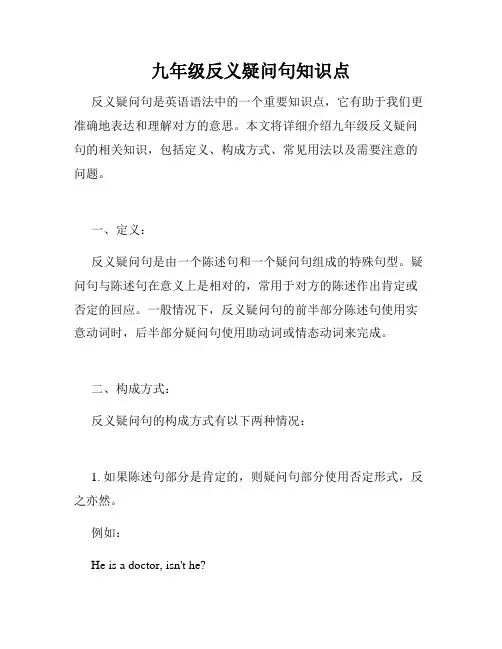
九年级反义疑问句知识点反义疑问句是英语语法中的一个重要知识点,它有助于我们更准确地表达和理解对方的意思。
本文将详细介绍九年级反义疑问句的相关知识,包括定义、构成方式、常见用法以及需要注意的问题。
一、定义:反义疑问句是由一个陈述句和一个疑问句组成的特殊句型。
疑问句与陈述句在意义上是相对的,常用于对方的陈述作出肯定或否定的回应。
一般情况下,反义疑问句的前半部分陈述句使用实意动词时,后半部分疑问句使用助动词或情态动词来完成。
二、构成方式:反义疑问句的构成方式有以下两种情况:1. 如果陈述句部分是肯定的,则疑问句部分使用否定形式,反之亦然。
例如:He is a doctor, isn't he?He isn't a doctor, is he?2. 如果陈述句部分使用助动词或情态动词,疑问句部分使用主要动词。
例如:You can swim, can't you?You can't swim, can you?三、常见用法:九年级阶段,学生需要掌握反义疑问句的常见用法,以下是一些例子:1. 表示请求或征求对方的意见或确认:You will come to the party, won't you?Let's go for a walk, shall we?2. 表示对方的推测并确认:She is your sister, isn't she?3. 表示对方的意见并征求同意或否定:You don't mind if I sit here, do you?4. 表示对方的实际情况并征求确认:You have finished your homework, haven't you?四、需要注意的问题:在使用反义疑问句时,需要注意以下几个问题:1. 人称和时态的一致性:主语的人称和时态需与疑问句的主语相对应,否则会造成语法错误。
例如:She is a doctor, isn't they?(错误)She is a doctor, isn't she?(正确)2. 答案的选择:对于反义疑问句,回答要根据前半部分陈述句而定。
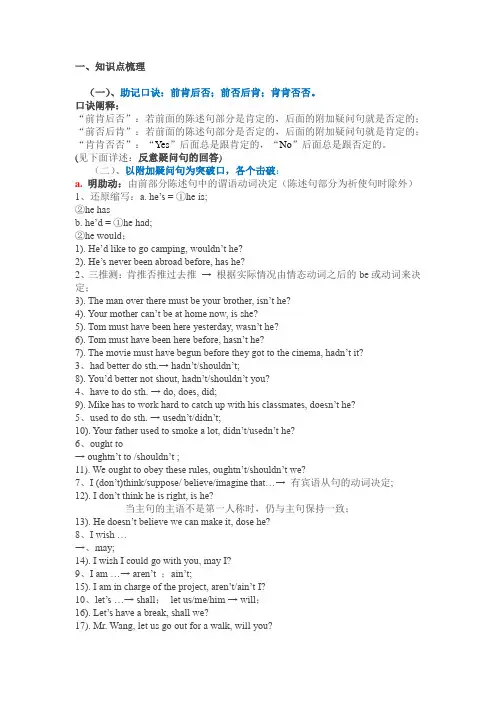
一、知识点梳理(一)、助记口诀:前肯后否;前否后肯;肯肯否否。
口诀阐释:“前肯后否”:若前面的陈述句部分是肯定的,后面的附加疑问句就是否定的;“前否后肯”:若前面的陈述句部分是否定的,后面的附加疑问句就是肯定的;“肯肯否否”:“Y es”后面总是跟肯定的,“No”后面总是跟否定的。
(见下面详述:反意疑问句的回答)(二)、以附加疑问句为突破口,各个击破:a. 明助动:由前部分陈述句中的谓语动词决定(陈述句部分为祈使句时除外)1、还原缩写:a. he’s = ①he is;②he hasb. he’d = ①he had;②he would;1). He’d like to go camping, wouldn’t he?2). He’s never been abroad before, has he?2、三推测:肯推否推过去推→ 根据实际情况由情态动词之后的be或动词来决定;3). The man over there must be your brother, isn’t he?4). Y our mother can’t be at home now, is she?5). Tom must have been here yesterday, wasn’t he?6). Tom must have been here before, hasn’t he?7). The movie must have begun before they got to the cinema, hadn’t it?3、had better do sth.→ hadn’t/shouldn’t;8). Y ou’d better not shout, hadn’t/shouldn’t you?4、have to do sth. → do, does, did;9). Mike has to work hard to catch up with his classmates, doesn’t he?5、used to do sth. → usedn’t/didn’t;10). Y our father used to smoke a lot, didn’t/usedn’t he?6、ought to→ oughtn’t to /shouldn’t ;11). We ou ght to obey these rules, oughtn’t/shouldn’t we?7、I (don’t)think/suppose/ believe/imagine that…→ 有宾语从句的动词决定; 12). I don’t think he is right, is he?当主句的主语不是第一人称时,仍与主句保持一致;13). He doesn’t believe we can make it, dose he?8、I wish …→、may;14). I wish I could go with you, may I?9、I am …→ aren’t ;ain’t;15). I am in charge of the project, aren’t/ain’t I?10、let’s …→ shall;let us/me/him → will;16). Let’s have a break, shall we?17). Mr. Wang, let us go out for a walk, will you?18). Dad, let me play computer games for a short while, will you?11、need与dare → 先判“实情”(实意动词还是情态动词)再定夺;19). Tom needn’t leave now, need he?20). Y our car needs cleaning, doesn’t it?21). He dares to go out at night, doesn’t he?22). Y ou daren’t kill me, dare you?12、感叹句→ 视情况而定。
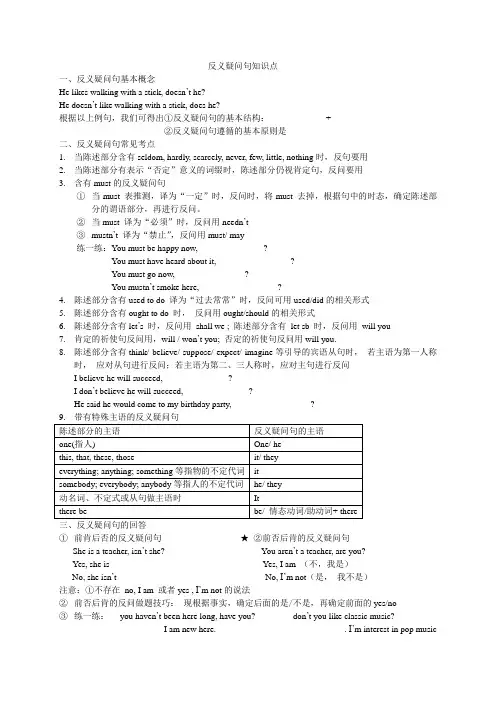
反义疑问句知识点一、反义疑问句基本概念He likes walking with a stick, doesn’t he?He doesn’t like walking with a stick, does he?根据以上例句,我们可得出①反义疑问句的基本结构:_____________+____________②反义疑问句遵循的基本原则是________________________二、反义疑问句常见考点1.当陈述部分含有seldom, hardly, scarcely, never, few, little, nothing时,反句要用_________2.当陈述部分有表示“否定”意义的词缀时,陈述部分仍视肯定句,反问要用__________3.含有must的反义疑问句①当must 表推测,译为“一定”时,反问时,将must 去掉,根据句中的时态,确定陈述部分的谓语部分,再进行反问。
②当must 译为“必须”时,反问用needn’t③mustn’t 译为“禁止”,反问用must/ may练一练:You must be happy now, _______ _______?You must have heard about it, _________ _______?You must go now, ________ _______?You mustn’t smoke here, _________ ________?4.陈述部分含有used to do 译为“过去常常”时,反问可用used/did的相关形式5.陈述部分含有ought to do 时,反问用ought/should的相关形式6.陈述部分含有let’s 时,反问用shall we ; 陈述部分含有let sb 时,反问用will you7.肯定的祈使句反问用,will / won’t you; 否定的祈使句反问用will you.8.陈述部分含有think/ believe/ suppose/ expect/ imagine等引导的宾语从句时,若主语为第一人称时,应对从句进行反问;若主语为第二、三人称时,应对主句进行反问I believe he will succeed, _______ _______?I don’t believe he will succeed, _______ _______?He said he would come to my birthday party, _________ ________?①前肯后否的反义疑问句★②前否后肯的反义疑问句---- She is a teacher, isn’t she? ---- You aren’t a teacher, are you?---- Yes, she is ---- Yes, I am (不,我是)No, she isn’t No, I’m not(是,我不是)注意:①不存在no, I am 或者yes , I’m not的说法②前否后肯的反问做题技巧:现根据事实,确定后面的是/不是,再确定前面的yes/no③练一练:--- you haven’t been here long, have you? ----don’t you like classic music?---___________I am new here. -----__________. I’m interest in pop music。

反义疑问句的用法总结相关热词搜索:反义疑问句的口诀反义疑问句复数法语反义疑问词反义疑问句宾语从句篇一:反义疑问句的用法一、基本用法与结构反意疑问句由两部分组成:前一部分是一个陈述句,后一部分是一个简短的疑问句,“陈述句+简略疑问句”。
第一部分提出一种看法,第二部分用来质疑或表示证实。
俩部分的人称时态应保持一致,陈述部分为肯定式时,疑问部分用否定式,陈述部分为否定式时,疑问部分用肯定式。
前肯后否,前否后肯。
You’re a student,aren’t you?M s smith isn’t a nurse, is she? (附加疑问句中的主语用主格)He can speakEnglish, can’t he? (附加疑问句中的主语用主格)He came early,didn’t he? (附加疑问句中的主语用主格)He likes English, doesn’t he? 他喜欢英语,是吗, (附加疑问句中的主语用主格)He doesn’t like English, does he? 他不喜欢英语,是吗, (附加疑问句中的主语用主格)【注】1. 若陈述部分含有seldom, hardly, never, few, litter, barely, scarcely, none, rarely, nothing,等否定词或半否定词,其疑问部分要用肯定式:He has few friends here, has he? 他在这儿几乎没什么朋友,是吗, She said nothing, did she? 她什么也没说,是不是,He can hardly swim, can he?They seldom come late, do they ?2. 若陈述部分含有带否定前缀un-, dis-, no-等,或者否定后缀:less,等表示否定意义的词如unhappy, dislike, unfriendly等,当看肯定句处理,疑问部分仍用否定式: The girl dislikeshistory, doesn’t she?It is unfair, isn’t it? 这不公平,不是吗?He looks unhappy, doesn’t he?It is impossible, isn’t it? 那是不可能的,是吗?二、反意疑问句的主语问题1. 基本原则:疑问部分的主语应与陈述部分主语一致,且只能是代词:误:Mary is a nurse, isn’t Mary?正:Mary is anurse, isn’t she? 玛丽是护士,对吗,2. 当陈述部分为there be句型时,疑问部分仍用there作“主语”: Be + thereThere was nothing in the room, was there? 房间里什么也没有,是吗, There are some apples in the desk, aren’t there?t any There isn’milk left, is there?3. 当陈述部分的主语是指示代词时,疑问部分用it, they等代词:That is a new car, isn’t it? 这是一辆新汽车,是吗?4. 当陈述部分的主语是复合不定代词时,为somebody, someone, everyone, everybody, no one, nobody等复合不定代词,其反意疑问句的主语在正式文体中用he,在口语或非正式文体中通常用they:Nobody was late, were they? 没有一个人迟到,是吗?当陈述部分的主语是 something, anything, nothing, everything等复合不定代词时,其反意疑问句的主语要用it:Everything is ready, isn’t it? 一切都准备好了吗,Nothing is important, is it? 没有什么重要的,不是吗?三、陈述部分有动词have的反意疑问句1. 当 have 为助动词时,其反意疑问句沿用同样的助动词:He has already left, hasn’t he? 他已经离开了,是吗?2. 当 have 为实意动词时,要分两种情况:? 若表示“所有”,反意疑问句可以用have,也可以用do:He has a lot of friends here, hasn’t [doesn’t] he? 他在这儿有许多朋友,是吗,但是若陈述部分用的是have的否定式,反意疑问句用have 还是用do,取决于陈述部分的动词形式:He hasn’t any money, has he? 他没有钱,是吗?He doesn’t have any money, does he? 他没有钱,是吗?? 若表示“吃”、“玩”等意思,反意疑问句要用do:He has supper at5, doesn’t he? 他5点吃晚餐,是吗?He had a goodtime at the party, didn’t he? 他在晚会上玩得很开心,是吗?3. 当用于have to时,通常也有两种可能:若表示经常性的行为,则多用加助动词do的形式;若表示特定的行为,则多用have:He often has toget up early, doesn’t he? 他经常要早起,是吗?He has to go tobed late tonight, hasn’t he? 他今晚要迟睡,是吗?四、含情态动词的反意疑问句1. 基本原则:在通常情况下,当陈述部分含有情态动词时,疑问部分会重复前面同样的情态动词:He can speakEnglish, can’t he,他会说英语,是吗,We shouldn’t go, should we? 我们不应该去,对不对,2. 当陈述部分含有must时,要分两种情况:? 若must表示“必须”或“有必要”,疑问部分用mustn’t 或needn’t:You must leave at once, mustn’t [needn’t] you? 你必须(有必要)马上离开,是吗?但是若陈述部分有mustn’t表示禁止,疑问部分要must:You mustn’t laugh, must you? 你不准笑,知道吗?? 若must表示推测,疑问部分不能用must,而应根据must后的动词结构采用相应的动词形式:He must be tired, isn’t he? 他一定累了,是吗?五、陈述部分为祈使句的反意疑问句1. 基本原则:若陈述部分为祈使句,疑问部分通常用will you:Please help us,will you? 请帮帮我们,好吗,Give me a hand ,will you?Come with us,will you? 同我们一起去,好吗,Don’t forget to post the letter, will you? 请别忘了寄信。

一、反意疑问句的意义及其构成反意疑问句又叫附加疑问句,是指当提问的人对前面所叙述的事实不敢肯定,而需要向对方加以证实时所提出的问句。
其结构为:前一部分是一个陈述句,后一部分是一个简单的问句。
完成后一部分简单问句时,要根据前面陈述句的动词时态和人称来选择适当的助动词进行提问,前后两部分的人称和动词时态要保持一致。
如果前一部分用肯定式,后一部分一般用否定式;反之,前一部分为否定式,后一部分要用肯定式,即“前肯定后否定,前否定后肯定”。
二、简单句式结构中反意疑问句的运用反意疑问句运用于简单句式结构中时,我们应注意掌握以下几个方面1、当陈述句部分的主语是名词时,反意疑问句的主语必须用人称代词来代替。
例Your brother has gone to the library, hasn’t he? 你弟弟去图书馆了,是吗?2、当陈述句的主语是指示代词this, that时,反意疑问句的主语用it代替;指示代词是these, those时,反意疑问句的主语用they代替。
例That isn’t a useful book, is it? 那不是一本有用的书,是吗?These are important reading materials, aren’t they? 这些都是重要的阅读材料,是吗?3、当陈述句部分是I am…时,反意疑问句部分通常要用aren’t I;如陈述句部分的主语是I am not时,反意疑问句部分通常要用am I。
例I’m late for the meeting, aren’t I? 我开会迟到了,是吗?I’m not doing well, am I? 我干得不好,是吗?4、当陈述部分是everyone / everybody, someone / somebody, no one / nobody, none等表示人的不定代词时,反意疑问句部分的主语多用they,但也可用he;当陈述部分的主语是everything, anything, something, nothing等表示物的不定代词时,反意疑问句部分的主语用it。
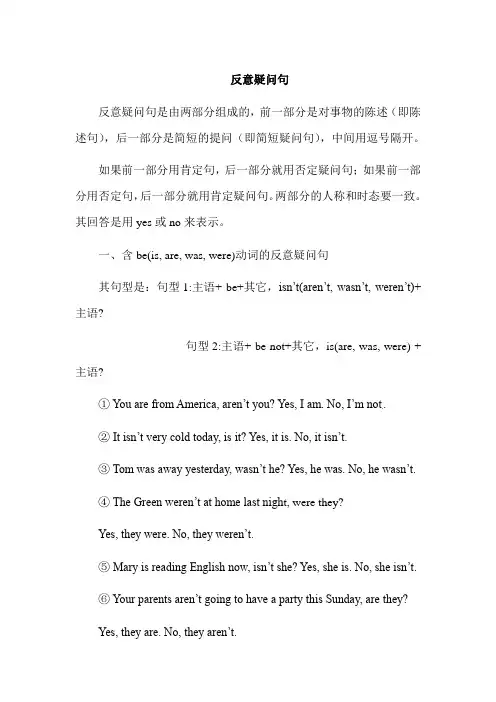
反意疑问句反意疑问句是由两部分组成的,前一部分是对事物的陈述(即陈述句),后一部分是简短的提问(即简短疑问句),中间用逗号隔开。
如果前一部分用肯定句,后一部分就用否定疑问句;如果前一部分用否定句,后一部分就用肯定疑问句。
两部分的人称和时态要一致。
其回答是用yes或no来表示。
一、含be(is, are, was, were)动词的反意疑问句其句型是:句型1:主语+ be+其它,isn’t(aren’t, wasn’t, weren’t)+ 主语?句型2:主语+ be not+其它,is(are, was, were) + 主语?① You are from America, aren’t you? Yes, I am. No, I’m not.② It isn’t very cold today, is it? Yes, it is. No, it isn’t.③ Tom was away yesterday, wasn’t he? Yes, he was. No, he wasn’t.④ The Green weren’t at home last nigh t, were they?Yes, they were. No, they weren’t.⑤ Mary is reading English now, isn’t she? Yes, she is. No, she isn’t.⑥ Your parents aren’t going to have a party this Sunday, are they?Yes, they are. No, they aren’t.⑦ Th e girls were singing when the teacher came in, weren’t they?Yes, they were. No, they weren’t.注意:There be句型① There is an old picture on the wall, isn’t there?Yes, there is. No, there isn’t.② There aren’t any children in the room, are there?Yes, there are. No, there aren’t.③ There wasn’t a telephone call for me, was there?Yes, there was. No, there wasn’t.④ There were enough people to pick apples, weren’t there?Yes, there were. No there weren’t.二、行为动词的一般现在时的反意疑问句其句型是:句型1: 主语+动词原形+其它,don’t I(you, we, they)?句型2: 主语+ don’t+动词原形+其它,do I(you, we, they)?句型3: 主语+动词第三人称单数+其它,doesn’t he(she, it)?句型4: 主语+ doesn’t+动词原形+其它,doeshe(she, it)?① You often watch TV in the evening, don’t you? Yes, I do. No, I don’t.② The students don’t study hard, do they? Yes, they do. No, they don’t.③ Mary studies Chinese hard, doesn’t she? Yes, she does. No, she doesn’t.④ The boy doesn’t often go to school by bike, does he?Yes, he does. No, he d oesn’t.⑤The first class begins at eight, doesn’t it? Yes, it does. No, it doesn’t.三、行为动词的一般过去时的反意疑问句其句型是:句型1: 主语+动词过去式+其它,didn’t+主语?句型2: 主语+didn’t+动词原形+其它,did +主语?① You watched TV last night, didn’t you? Yes, I did. No, I didn’t.②Jim’s parents didn’t go to Hong Kong last month, did they?Yes, they did. No, they didn’t.③ The rain stopped, didn’t it? Yes, it did. No, it didn’t.④Mr. Clarke didn’t buy a car, didn’t he? Yes, he did. No, he didn’t.四、一般将来时的反意疑问句其句型是:句型1: 主语+will+动词原形+其它,won’t+主语?句型2: 主语+ won’t +动词原形+其它,will +主语?①The boys will play games, won’t they? Yes, they will. No, they won’t.② It won’t stop raining, will it? Yes, it will. No, it won’t.③ Mr. Smith will visit our school next week, won’t he? Yes, he will. No, he won’t.注意:There be句型的一般将来时① There will be a basketball match tomorrow, won’t there?Yes, there will. No, there won’t.② There won’t be too much pollution in the future, will there?Yes, there will. No, there won’t.五、现在完成时的反意疑问句其句型是:句型1: 主语+have+动词过去分词+其它,haven’t+主语?句型2: 主语+ haven’t +动词过去分词+其它,have +主语?句型3: 主语+has+动词过去分词+其它,hasn’t+主语?句型4: 主语+ hasn’t +动词过去分词+其它,has +主语?① You have been to Shanghai before, haven’t you? Yes I have. No, I haven’t.② You haven’t been to Shanghai before, have you? Yes I have. No, I haven’t.③Jack has done his homework, hasn’t he? Yes, he has. No, he hasn’t.④Jack hasn’t done his homework, has he? Yes, he has. No, he hasn’t.六、现在完成进行时的反意疑问句其句型是:句型1: 主语+have been+动词现在分词+其它,haven’t+主语?句型2: 主语+ haven’t been +动词现在分词+其它,have +主语?句型3: 主语+has been +动词现在分词+其它,hasn’t+主语?句型4: 主语+ hasn’t been +动词现在分词+其它,has +主语?① You have been skating for five hours, haven’t you? Yes, I have. No, I haven’t.② You haven’t been skating for five hours, have you? Yes, I have. No, I haven’t.③ Bob has been collecting kites since 1999, hasn’t he? Yes, he has. No, he hasn’t.④ Bob hasn’t been collecting kites since 1999, has he? Yes, he has. No, he hasn’t.七、含有情态动词的反意疑问句其句型是:句型1: 主语+情态动词+动词原形+其它,情态动词否定形式+主语?句型2: 主语+情态动词否定形式+动词原形+其它,情态动词+主语?① You can speak French, can’t you? Yes, I can. No, I can’t.②They can’t understand me, can they? Yes, they can. No, th ey can’t.③ Ann could swim when she was six, couldn’t she? Yes, she could. No, she couldn’t.④ The students must study hard, mustn’t they? Yes, they must. No, they needn’t.注意:You must go home now, needn’t you? Yes, I must. No, I needn’t.★值得注意的是有时英语的谓语动词并不用否定式(即没加上not),而是用上了“never, little, few, hardly, nothing, nobody”等词,这时该陈述句也属于否定句,因此,反意疑问句的后半部分应用肯定疑问式。
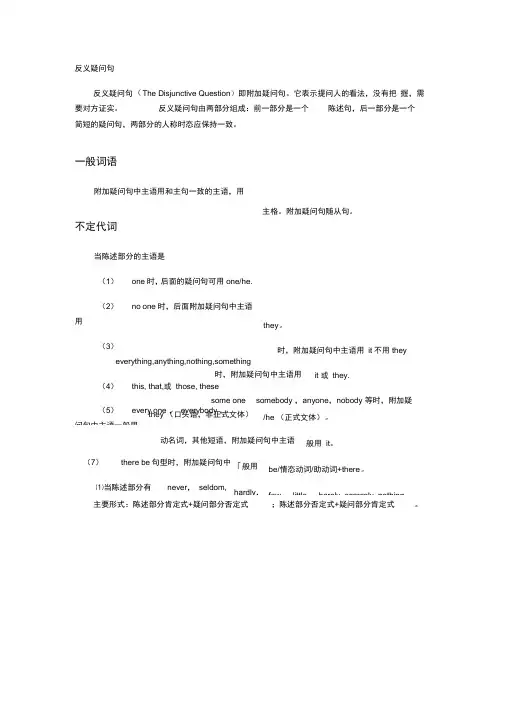
一般词语附加疑问句中主语用和主句一致的主语,用不定代词当陈述部分的主语是 (1) one 时,后面的疑问句可用one/he. (2) no one 时,后面附加疑问句中主语用(3)everything,anything,nothing,something (4)this, that,或 those, these(5) every one , everybody , 问句中主语一般用主格。
附加疑问句随从句。
they 。
时,附加疑问句中主语用 it 不用theyit 或 they.somebody ,anyone ,nobody 等时,附加疑/he (正式文体)。
般用 it 。
be/情态动词/助动词+there 。
few , little , barely, scarcely, nothing ,时,附加疑问句中主语用some one they (口头语,非正式文体) 动名词,其他短语,附加疑问句中主语 「般用hardly , (7)there be 句型时,附加疑问句中 ⑴当陈述部分有never , seldom,反义疑问句反义疑问句(The Disjunctive Question )即附加疑问句。
它表示提问人的看法,没有把 握,需要对方证实。
反义疑问句由两部分组成:前一部分是一个陈述句,后一部分是一个简短的疑问句,两部分的人称时态应保持一致。
主要形式:陈述部分肯定式+疑问部分否定式 ;陈述部分否定式+疑问部分肯定式 。
non e,rarely ,no, not, no one, no body, n either 为肯定形式:There're few apples in the basket, are there?He can hardly swim, can he?They seldom come late, do they?(2)当陈述部分的主语为等否定意义的词汇时,后面的反意疑问句则every on e,some on e,a nyone,no one等表示人的不定代词时,疑问部分的主语用they或he :Every one in your family is a teacher, aren ' t they'is n't he ?(3) 当陈述部分的主语为everythi ng,somethi ng,a nythi ng. nothi ng 等表示物的不定代词时,疑问部分的主语用it:Something is wrong with your watch, isn ' t it?⑷当陈述部分含有否定意思的词是un happy,dislike,u nfrie ndly,等含有否定词缀的派生词,也就是有un,dis,no-前缀、-less后缀等含有词缀而意思否定的词,当做肯定句处理,疑问部分要用否定形式。
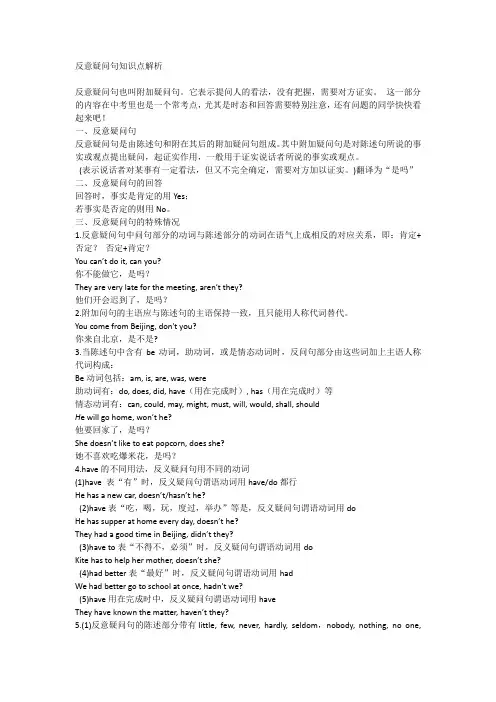
反意疑问句知识点解析反意疑问句也叫附加疑问句。
它表示提问人的看法,没有把握,需要对方证实。
这一部分的内容在中考里也是一个常考点,尤其是时态和回答需要特别注意,还有问题的同学快快看起来吧!一、反意疑问句反意疑问句是由陈述句和附在其后的附加疑问句组成。
其中附加疑问句是对陈述句所说的事实或观点提出疑问,起证实作用,一般用于证实说话者所说的事实或观点。
(表示说话者对某事有一定看法,但又不完全确定,需要对方加以证实。
)翻译为“是吗”二、反意疑问句的回答回答时,事实是肯定的用Yes;若事实是否定的则用No。
三、反意疑问句的特殊情况1.反意疑问句中问句部分的动词与陈述部分的动词在语气上成相反的对应关系,即:肯定+否定?否定+肯定?You can’t do it, can you?你不能做它,是吗?They are very late for the meeting, aren’t they?他们开会迟到了,是吗?2.附加问句的主语应与陈述句的主语保持一致,且只能用人称代词替代。
You come from Beijing, don't you?你来自北京,是不是?3.当陈述句中含有be动词,助动词,或是情态动词时,反问句部分由这些词加上主语人称代词构成:Be动词包括:am, is, are, was, were助动词有:do, does, did, have(用在完成时), has(用在完成时)等情态动词有:can, could, may, might, must, will, would, shall, shouldH e will go home, won’t he?他要回家了,是吗?She doesn’t like to eat popcorn, does she?她不喜欢吃爆米花,是吗?4.have的不同用法,反义疑问句用不同的动词(1)have 表“有”时,反义疑问句谓语动词用have/do都行He has a new car, doesn’t/hasn’t he?(2)have表“吃,喝,玩,度过,举办”等是,反义疑问句谓语动词用doHe has supper at home every day, doesn’t he?They had a good time in Beijing, didn’t they?(3)have to表“不得不,必须”时,反义疑问句谓语动词用doKite has to help her mother, doesn’t she?(4)had better表“最好”时,反义疑问句谓语动词用hadWe had better go to school at once, hadn't we?(5)have用在完成时中,反义疑问句谓语动词用haveThey have known the matter, haven’t they?5.(1)反意疑问句的陈述部分带有little, few, never, hardly, seldom,nobody, nothing, no one,none, neither等否定意义的词时,问句部分用肯定式。
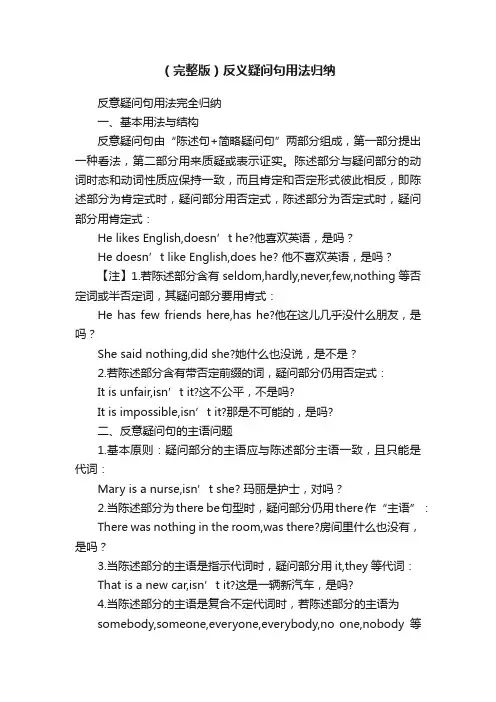
(完整版)反义疑问句用法归纳反意疑问句用法完全归纳一、基本用法与结构反意疑问句由“陈述句+简略疑问句”两部分组成,第一部分提出一种看法,第二部分用来质疑或表示证实。
陈述部分与疑问部分的动词时态和动词性质应保持一致,而且肯定和否定形式彼此相反,即陈述部分为肯定式时,疑问部分用否定式,陈述部分为否定式时,疑问部分用肯定式:He likes English,doesn’t he?他喜欢英语,是吗?He doesn’t like English,does he? 他不喜欢英语,是吗?【注】1.若陈述部分含有seldom,hardly,never,few,nothing等否定词或半否定词,其疑问部分要用肯式:He has few friends here,has he?他在这儿几乎没什么朋友,是吗?She said nothing,did she?她什么也没说,是不是?2.若陈述部分含有带否定前缀的词,疑问部分仍用否定式:It is u nfair,isn’t it?这不公平,不是吗?It is impossible,isn’t it?那是不可能的,是吗?二、反意疑问句的主语问题1.基本原则:疑问部分的主语应与陈述部分主语一致,且只能是代词:Mary is a nurse,isn’t she? 玛丽是护士,对吗?2.当陈述部分为there be句型时,疑问部分仍用there作“主语”:There was nothing in the room,was there?房间里什么也没有,是吗?3.当陈述部分的主语是指示代词时,疑问部分用it,they等代词:That is a new car,isn’t it?这是一辆新汽车,是吗?4.当陈述部分的主语是复合不定代词时,若陈述部分的主语为somebody,someone,everyone,everybody,no one,nobody等复合不定代词,其反意疑问句的主语在正式文体中用he,在口语或非正式文体中通常用they:Nobody was late,were they?没有一个人迟到,是吗?5.当陈述部分的主语是something,anything,nothing,everything等复合不定代词时,其反意疑问句的主语要用it:Everything is ready,isn’t it? 一切都准备好了吗?Nothing is important,is it?没有什么重要的,不是吗?三、陈述部分有动词have的反意疑问句1.当have为助动词时,其反意疑问句沿用同样的助动词:He has already left,hasn’t he?他已经离开了,是吗?2.当have为实意动词时,要分两种情况:①若表示“所有”,反意疑问句可以用have,也可以用do:He has a lot of friends here,hasn’t[doesn’t]he?他在这儿有许多朋友,是吗?但是若陈述部分用的是have的否定式,反意疑问句用have还是用do,取决于陈述部分的动词形式:He hasn’t any money,has he?他没有钱,是吗?He doesn’t have any money,does he?他没有钱,是吗?②若表示“吃”、“玩”等意思,反意疑问句要用do:He has suppe r at5,doesn’t he? 他5点吃晚餐,是吗?He had a good time at the party,didn’t he?他在晚会上玩得很开心,是吗?3.当用于have to时,通常也有两种可能:若表示经常性的行为,则多用加助动词do的形式;若表示特定的行为,则多用have:He often has to get up early,doesn’t he?他经常要早起,是吗?He has to go to bed late tonight,hasn’t he?他今晚要迟睡,是吗?四、含情态动词的反意疑问句1.基本原则:在通常情况下,当陈述部分含有情态动词时,疑问部分会重复前面同样的情态动词:He can speak English,can’t he?他会说英语,是吗?We shouldn’t go,should we?我们不应该去,对不对?2.当陈述部分含有must时,要分两种情况:①若must表示“必须”或“有必要”,疑问部分用mustn’t或needn’t:You must leave at once,mustn’t[needn’t]you?你必须(有必要)马上离开,是吗?但是若陈述部分有mustn’t表示禁止,疑问部分要must:You mustn’t laugh,must you?你不准笑,知道吗?②若must表示推测,疑问部分不能用must,而应根据must后的动词结构采用相应的动词形式:He must be tired,isn’t he?他一定累了,是吗?五、陈述部分为祈使句的反意疑问句1.基本原则:若陈述部分为祈使句,疑问部分通常用will you:Please help us,will you?请帮帮我们,好吗?Come with us,will you?同我们一起去,好吗?Don’t forget to post the letter,will you?请别忘了寄信。
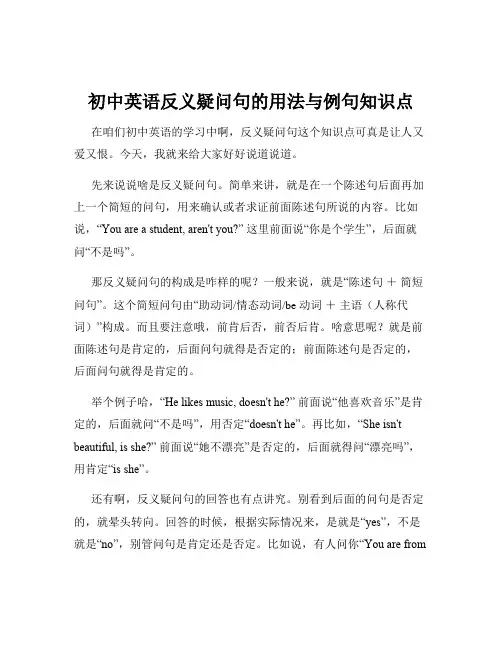
初中英语反义疑问句的用法与例句知识点在咱们初中英语的学习中啊,反义疑问句这个知识点可真是让人又爱又恨。
今天,我就来给大家好好说道说道。
先来说说啥是反义疑问句。
简单来讲,就是在一个陈述句后面再加上一个简短的问句,用来确认或者求证前面陈述句所说的内容。
比如说,“You are a student, aren't you?” 这里前面说“你是个学生”,后面就问“不是吗”。
那反义疑问句的构成是咋样的呢?一般来说,就是“陈述句+简短问句”。
这个简短问句由“助动词/情态动词/be 动词+主语(人称代词)”构成。
而且要注意哦,前肯后否,前否后肯。
啥意思呢?就是前面陈述句是肯定的,后面问句就得是否定的;前面陈述句是否定的,后面问句就得是肯定的。
举个例子哈,“He likes music, doesn't he?” 前面说“他喜欢音乐”是肯定的,后面就问“不是吗”,用否定“doesn't he”。
再比如,“She isn't beautiful, is she?” 前面说“她不漂亮”是否定的,后面就得问“漂亮吗”,用肯定“is she”。
还有啊,反义疑问句的回答也有点讲究。
别看到后面的问句是否定的,就晕头转向。
回答的时候,根据实际情况来,是就是“yes”,不是就是“no”,别管问句是肯定还是否定。
比如说,有人问你“You are fromChina, aren't you?” 如果你确实来自中国,那就回答“Yes, I am” 可别因为后面是“aren't you”就搞糊涂啦。
我还记得我上初中那会,有一次英语课上,老师正在讲反义疑问句。
当时老师举了个例子,“You have finished your homework, haven't you?”然后老师就点了我同桌起来回答。
我那同桌啊,平时英语就不太好,站起来一脸懵。
支支吾吾半天,最后来了一句:“I don't know” 全班同学都笑了,老师也哭笑不得,又给他耐心地解释了一遍。
最新中考反义疑问句知识点习题带答案-CAL-FENGHAI-(2020YEAR-YICAI)_JINGBIAN反义疑问句【反义疑问句】(一)概念:反意疑问句是由陈述句和附在其后的附加疑问句组成。
其中附加疑问句是对陈述句所说的事实或观点提出疑问,起证实作用,一般用于证实说话者所说的事实或观点。
(二)要点注意:1、反意疑问句前后两部分谓语应是:“肯定陈述+否定疑问”或“否定陈述+肯定疑问”。
2、简略问句如果是否定式:not应与be,do,will等系动词、助动词、情态动词缩写。
3、简略问句的主语不用名词,应用人称代词。
4、陈述部分含“too...to”时,是否定句。
(三)用法:1) 陈述部分I am时,疑问部分要用 aren't I.I'm as tall as your sister,aren't I(我和你姐姐一样高,对吗)2) 陈述部分用 no, nothing, nobody, never, few, little, seldom, hardly等否定含义的词时,疑问部分用肯定含义。
如: The old man made no answer, did he?Jim is never late for school, is he?3) 陈述部分有情态动词have to +v. (had to + v.),疑问部分常用don't +主语(didn't +主语)。
We have to get there at eight tomorrow, don't we?used to,疑问部分用didn't +主语或 usedn't +主语。
He used to take pictures there, didn't he / usedn't hehad better(最好) + v. 疑问句部分用hadn't you?You'd better read it by yourself, hadn't you?4) 陈述部分有would rather(宁可、宁愿) +v.,疑问部分多用 wouldn't +主语。
反义疑问句:反义疑问句(The Disjunctive Question) 即附加疑问句。
它表示提问人的看法,没有把握,需要对方证实。
反义疑问句由两部分组成:前一部分是一个陈述句,后一部分是一个简短的疑问句,两部分的人称时态应保持一致。
主要形式:陈述部分肯定式+疑问部分否定式;陈述部分否定式+疑问部分肯定式。
一般词语附加疑问句中主语用和主句一致的主语,用主格。
附加疑问句随从句。
不定代词当陈述部分的主语是(1)one时,后面的疑问句可用one/he.(2)no one时,后面附加疑问句中主语用they。
(3)everything,anything,nothing,something时,附加疑问句中主语用it 不用they(4)this, that,或those, these时,附加疑问句中主语用it或they.(5)everyone,everybody,someone,somebody,anyone,nobody等时,附加疑问句中主语一般用they(口头语,非正式文体)/he(正式文体)。
(6)不定式时,动名词,其他短语,附加疑问句中主语一般用it。
(7)there be句型时,附加疑问句中一般用be/情态动词/助动词+there。
(1)当陈述部分有never,seldom, hardly,few,little,barely, scarcely, nothing,none,rarely ,no, not, no one, nobody, neither等否定意义的词汇时,后面的反意疑问句则为肯定形式:There're few apples in the basket, are there?He can hardly swim, can he?They seldom come late, do they?(2)当陈述部分的主语为everyone,someone,anyone,no one等表示人的不定代词时,疑问部分的主语用they或he:Everyone in your family is a teacher, aren’t they\isn't he?(3)当陈述部分的主语为everything,something,anything.nothing等表示物的不定代词时,疑问部分的主语用it:Something is wrong with your watch, isn’t it?(4)当陈述部分含有否定意思的词是unhappy,dislike,unfriendly,等含有否定词缀的派生词,也就是有un,dis,no-前缀、-less后缀等含有词缀而意思否定的词,当做肯定句处理,疑问部分要用否定形式。
如:He looks unhappy,doesn’t he? 他看上去不高兴,不是吗?The girl dislikes history,doesn’t she? 这女孩不喜欢历史,不是吗?(5)当陈述部分有less, fewer等词视为肯定词,疑问部分用否定形式。
There will be less pollution, won't there?表示主语的词含有think, believe, suppose, imagine, expect等动词后接宾语从句构成的主从复合句在构成反意疑问句时,视情况不同有两种不同的构成方式。
(即当主句是I think,I believe,I suppose,I imagine,I expect时要反问从句,其余句式均反问主句。
)(1)当主句的主语为第一人称时,其后的简短问句应与从句相一致。
例如:I expect our English teacher will be back this weekend, won't she/he?We suppose you have finished the project, haven't you?值得注意的是,当这些动词后接的宾语从句的否定转移到主句时,其仍属否定句,故其后的简短问句应用肯定式,而非否定式。
例如:I don't believe that he can translate this book, can he?We don't imagine the twins have arrived, have they?此类句子的回答同"前否后肯"型反意疑问句一样,如上述后一个句子,若双胞胎已经到了,则回答为"Yes, they have.";若尚未到达,使用"No, they haven't."。
(2)当主句的主语为第二、三人称时,其后的简短问句则应与主句相一致(此时,否定只看主句,与从句无关)。
例如:Your sister supposes she needs no help, doesn't she?You thought they could have completed the project, didn't you?They don't believe she's an engineer, do they?She doesn't expect that we are coming so soon, does she?(3)但如果主句的时态是过去时等等,疑问句应和主句的人称时态保持一致。
better陈述部分有had better,或其中的had表示完成时态时,疑问句应用hadn’t等开头:You’d better get up early, hadn’t you?其他情况句中有have时疑问句应用don't等开头如have表示“有”的时候,有两种形式:(have 表示有可用do或have来改写)-He has two sisters,doesn’t he? =He has two sisters, hasn’t he?-He doesn't have any sisters,does he?祈使句当陈述部分是祈使句时,疑问句要根据语气来表达,分三种情况:1)一般情况下用will you 或won't you。
Give me a hand, will you?Leave all the things as they are, won’t you?2)以Let's(听者包括在内)开头的祈使句,前肯后可肯可否,疑问句必须用shall we (shall只用于第一人称);只有以Let us(听话人不被包括在“us”里面)或Let me开头的祈使句,问句才用will you。
Let us know the time of your arrival, will you?Let's try again, shall we?Let me help you, will you?Let’s have a look on your book,shall we?3)当陈述句是否定的祈使句时,问句可用will you 或can you 。
e.g. don’t make much noise, will/can you?There be句型There be 句型中,反义疑问部分必须为be 动词+ thereThere are some apples in the basket, aren't there?There isn't any milk left, is there?there used to be,反义疑问句有两种形式:didn't there和usedn't there.There used to be some cities wall, usedn't there? 或:There used to be some cities wall, didn't there?Must.当陈述部分有情态动词must,问句有4种情况:(1)mustn't表示“禁止,不可,不必”时,附加问句通常要用must.You mustn't stop your car here, must you?你不能把车停在这地方,知道吗?(2)must表示“有必要”时,附加问句通常要用needn't.They must finish the work today, needn’t they?他们今天要完成这项工作,是吗?(3)must be表推测,用来表示对现在的情况进行推测时,问句通常要根据must后面的动词采用相应的形式。
He must be good at English, isn’t he? 他英语一定学得很好,是吗?She must be a good English teacher, isn’t she? 她一定是位优秀的英语老师,是吗?(4)当must have done表示对过去的情况进行推测(一般句中有明确的过去时间状语),问句要根据陈述部分谓语的情况用“didn't+主语”或“wasn't/weren't+主语”;如果强调动作的完成(一般没有明确的过去时间状语),问句要用“haven't/hasn't+主语”。
She must have read the novel last week, didn’t she?她上星期一定读了这本小说,不是吗?You must have told her about it, haven’t you?你一定把这事告诉她了,不是吗?回答反意疑问句的回答:前肯后否,前否后肯,根据事实从后往前翻译。
如:(1)They work hard,don’t they?他们努力工作,不是吗?Yes, they do.对,他们工作努力。
/No, they don't.不,他们工作不努力(2)They don’t work hard, do they? 他们不太努力工作,是吗?Yes, they do. 不,他们工作努力。
/No, they don't. 是的,他们工作不努力否定反义疑问句的回答当陈述部分为肯定式,反义疑问句为否定式时,其回答一般不会造成困难,一般只需照情况回答即可:"It’s new, isn’t it?" "Yes, it is." “是新的,不是吗?”“是,是新的。
”"He wants to go, doesn’t he?" "No, he doesn’t." “他想去,不是吗?”“不,他不想去。